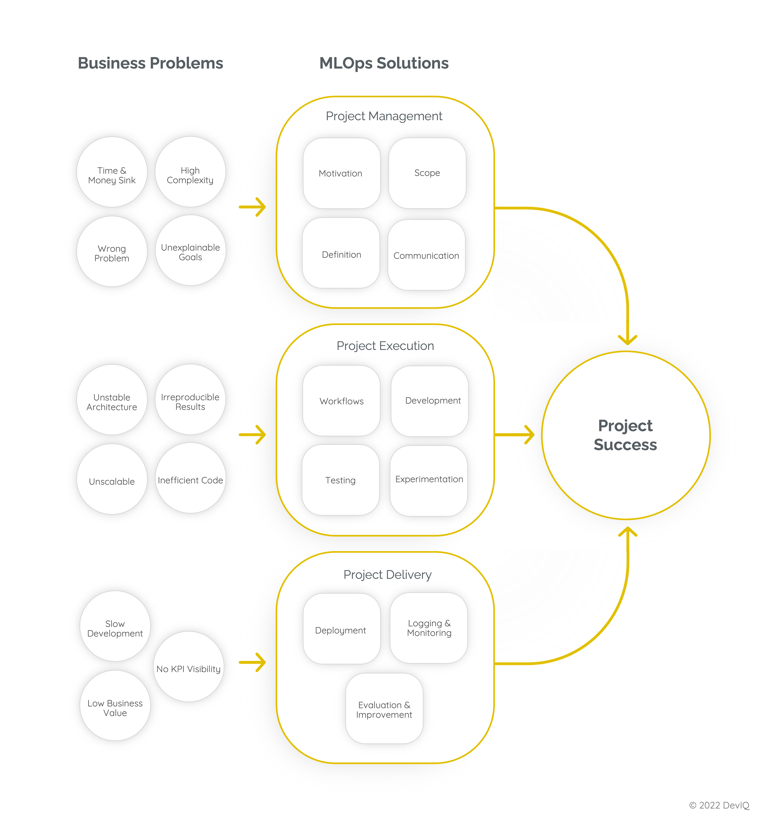By focusing on deliberate deployment, robust logging and monitoring, and continuous evaluation and improvement, MLOps ensures that project delivery consistently meets business objectives and delivers real value.
In this final article of our series on Machine Learning Operations (MLOps), we explore the critical final stage of a data science project: project delivery. Throughout this series, we have discussed the importance of MLOps in project management and efficient execution, and how these elements work together to drive success in machine learning initiatives. Now, we turn our attention to ensuring that these projects are delivered promptly and effectively to the customer, avoiding common pitfalls such as slow development, lack of visibility, and cost overruns.

The Importance of Project Delivery in MLOps
Project delivery is the culmination of all prior work. After successfully navigating the stages of structured project management and efficient project execution, timely and reliable delivery is paramount. MLOps clears this final hurdle by demanding that project delivery is not just timely, but also structured in a way that mitigates common delivery pitfalls, such as:
- Slow development, deployment, and updates: These delays can derail a project’s momentum and reduce its impact.
- Little or no KPI visibility: Without clear metrics, it’s difficult for stakeholders to see the value being delivered.
- The project cost exceeds business value: If the cost of delivery outweighs the benefits, the project ultimately fails to provide the desired return on investment.
By focusing on deliberate deployment, robust logging and monitoring, and continuous evaluation and improvement, MLOps ensures that project delivery consistently meets business objectives and delivers real value.
Deployment: Bringing Models to Life
Successful project delivery necessitates rapid deployments that use simple, scalable methods and platforms. In MLOps, deployment is not just about getting models into production quickly; it’s about ensuring they are robust, scalable, and maintainable. Key aspects of deployment include:
- Continuous Integration (CI): Automate the running of tests, building of source code, and development of deployment artifacts. This ensures that models are constantly validated and ready for production.
- Continuous Delivery (CD): Deploy pipelines directly to the target environment, ensuring that updates are swift and reliable.
- Simplicity and Scalability: Choose deployment methods and platforms that abstract complexity, allowing for easy scaling, monitoring, and API functionality.
- Security: Prioritize infrastructure security by ensuring data protection, authorization, and authentication are in place.
- Reproducibility: Maintain clear lineage and source control for all deployment artifacts to ensure consistency and replicable deployments across environments.
By focusing on these elements, teams can avoid the common pitfall of slow deployment, ensuring that machine learning models are delivered quickly and efficiently to meet business needs.
Logging and Monitoring: Maintaining KPI Visibility
After deployment, the work doesn’t stop. Continuous logging and monitoring are critical to ensure that the solution operates as expected and continues to deliver value. One of the common pitfalls in project delivery is the lack of KPI visibility, which can make it difficult for stakeholders to understand the performance and impact of the deployed models. Key activities in logging and monitoring include:
- Model Monitoring: Implement comprehensive monitoring to track metrics like data drift, target drift, and concept drift. This ensures that the model continues to perform well as the underlying data or business environment changes.
- KPI Tracking: Ensure that key performance indicators (KPIs) are visible to stakeholders by implementing robust logging mechanisms. This can be achieved by setting up a model registry to store trained models, a feature store for model training and serving data, and a metadata store that tracks parameters, training data, test data, and metric results.
- Infrastructure Monitoring: Keep a close watch on system metrics like CPU load, memory usage, and latency to identify bottlenecks and scale resources appropriately.
By maintaining KPI visibility, organizations can ensure that their models continue to deliver the expected business value and can quickly identify and address any issues that arise.
Evaluation and Improvement: Continuous Enhancement
Continuous evaluation and improvement are critical to ensuring long-term success. Regular assessment of model performance allows teams to refine or replace models when necessary to meet evolving business objectives. Key focus areas include:
- Performance Metrics: Regularly record and analyze performance metrics to identify trends and anticipate future issues.
- Model Evaluation: Use a staging environment to validate model performance against benchmark data before making it live.
- Infrastructure Costs: Monitor and optimize infrastructure costs by balancing accuracy, latency, and throughput requirements.
- Automated Validation: Implement automated checks to quickly detect and correct performance degradation.
Finally, continuous evaluation and improvement of the data and algorithms ensure that the results obtained from the solution are current and continue to provide significant business value. This approach gives customers confidence that their machine learning models remain relevant and effective, ensuring that the project continues to deliver on its promises.
Conclusion: Delivering Value with MLOps
Project delivery is the final hurdle in the MLOps process, but it is no less critical than the preceding stages. By focusing on structured deployment, continuous monitoring, and relentless evaluation, MLOps enables organizations to deliver machine learning projects that provide significant business value.
This approach ensures that data science initiatives do not stall at the final stage but instead translate into real-world success. With MLOps, companies can navigate the complexities of machine learning and emerge with robust, scalable, and impactful solutions.
This article is the final part of a DevIQ series on MLOps. Continue exploring this topic:
DevIQ on MLOps: Structured Project Management
DevIQ on MLOps: Efficient Project Execution
DevIQ on MLOps: What is MLOps? A Standard Operating Procedure for Success

